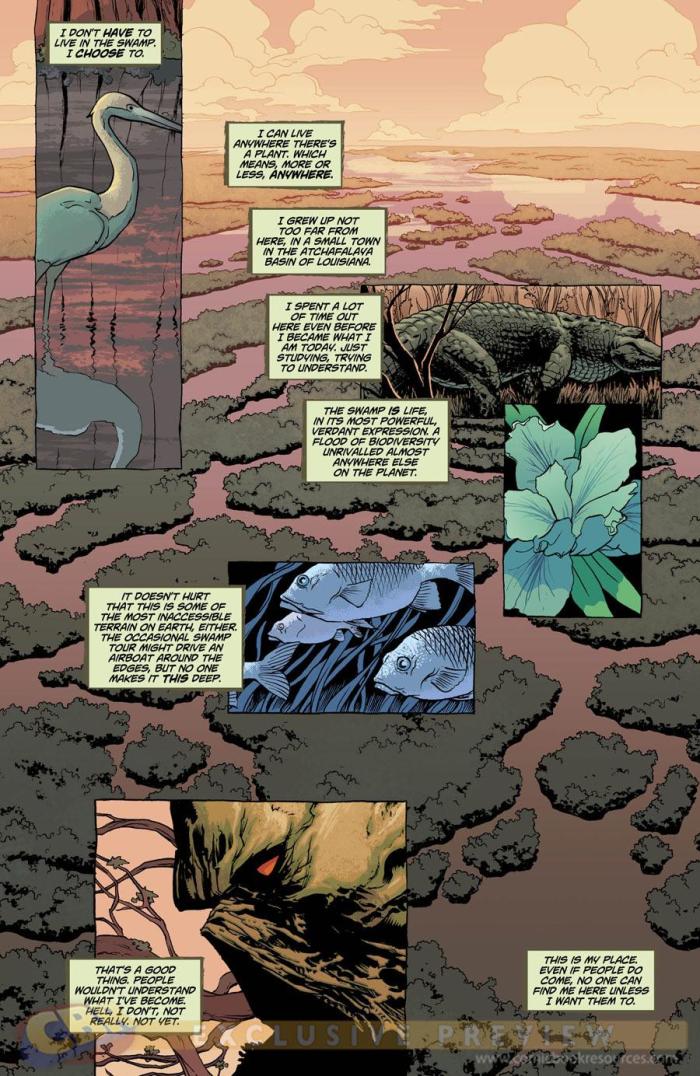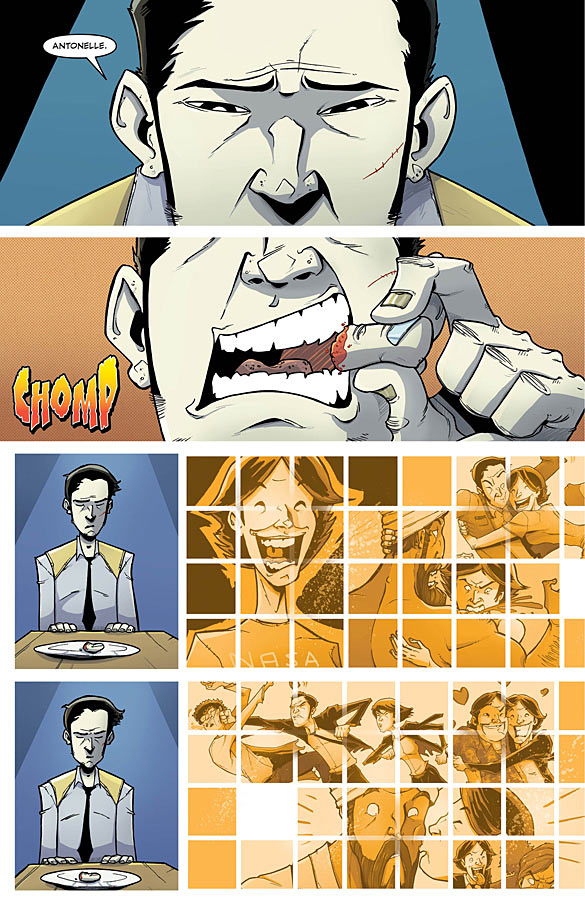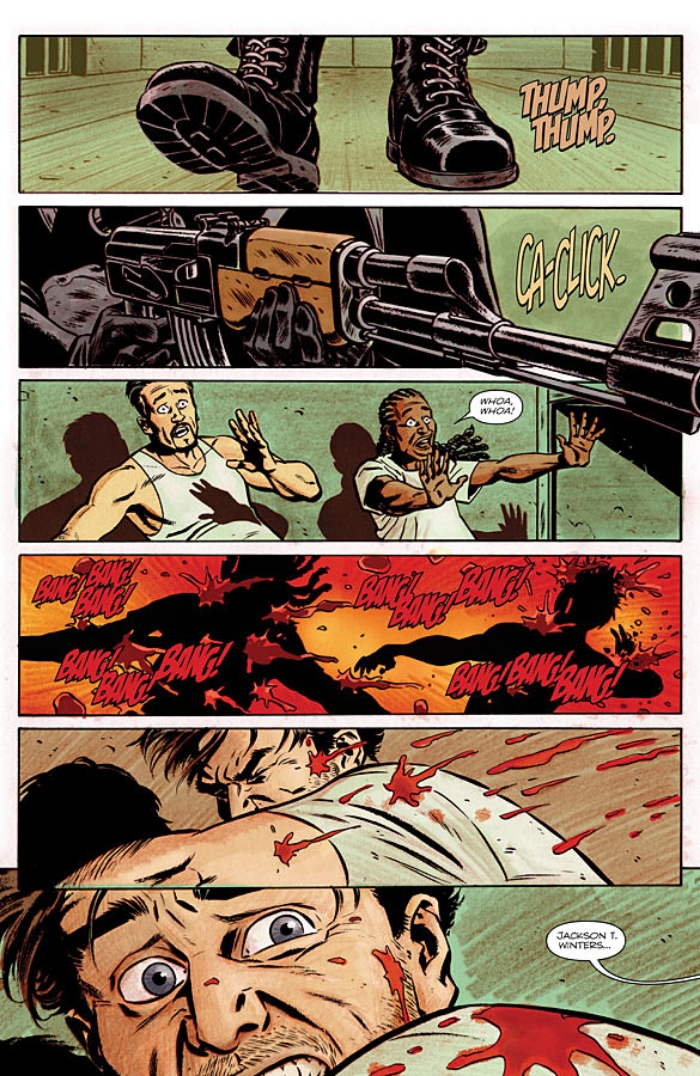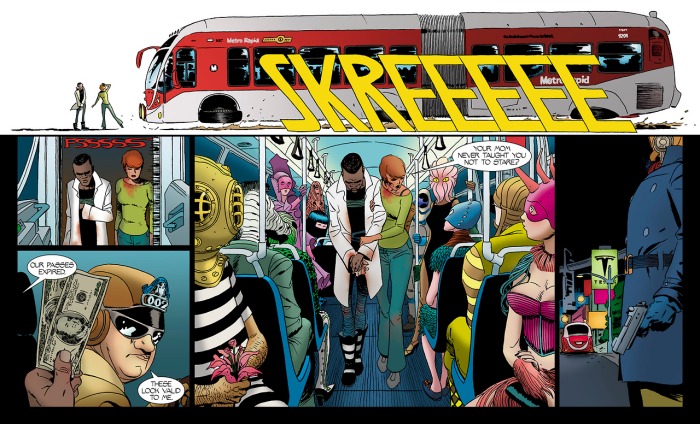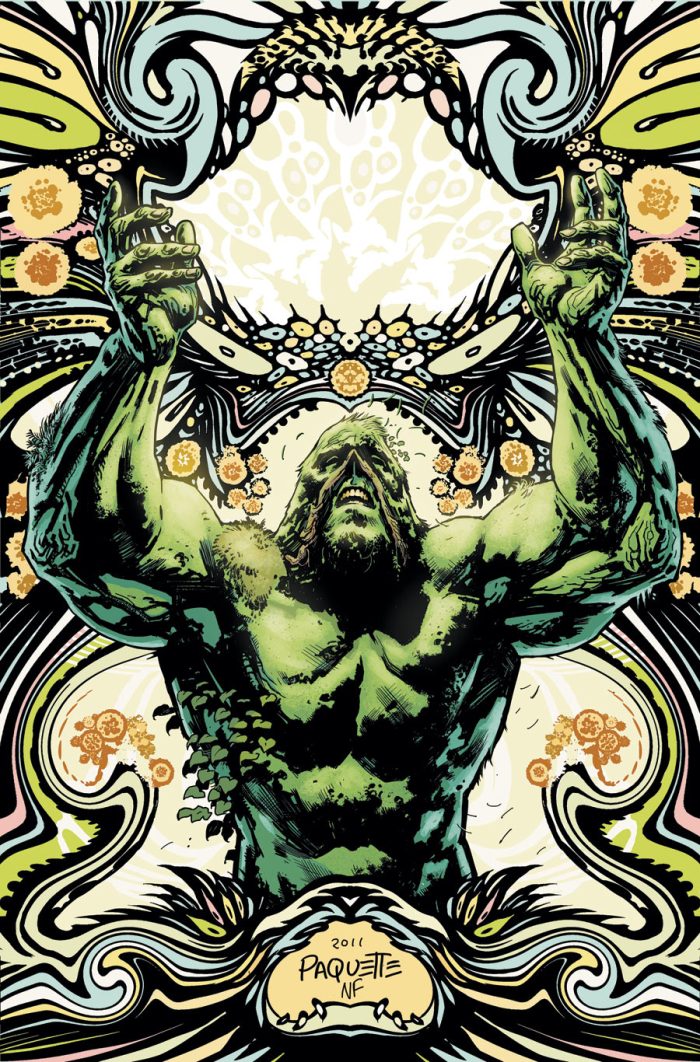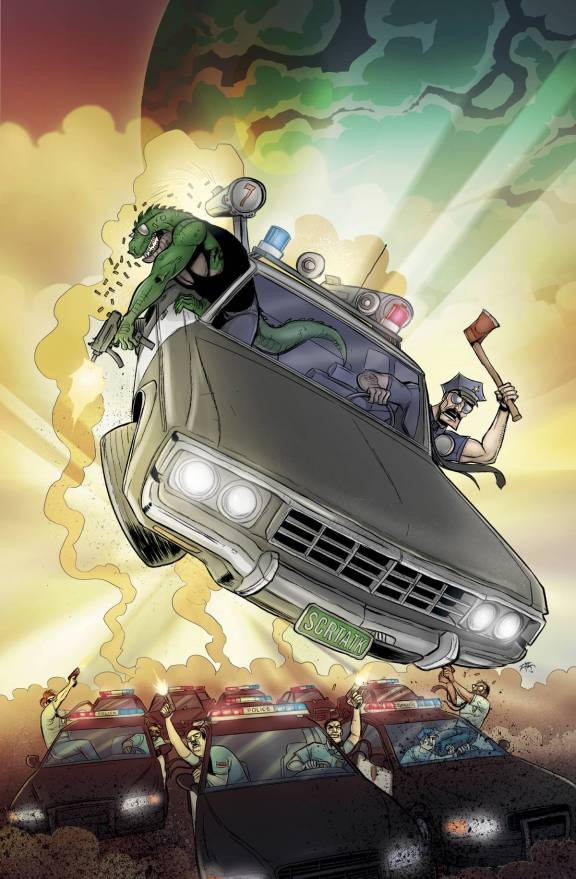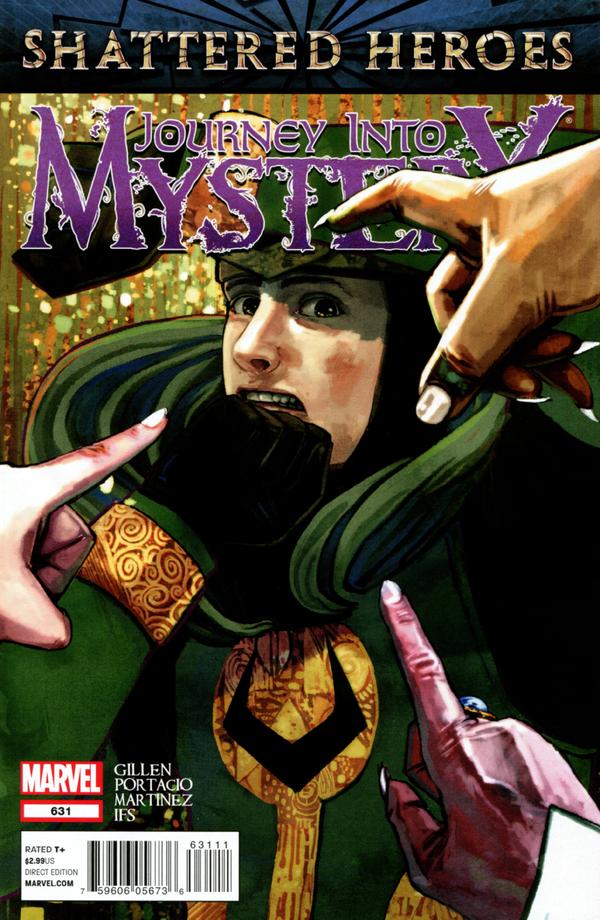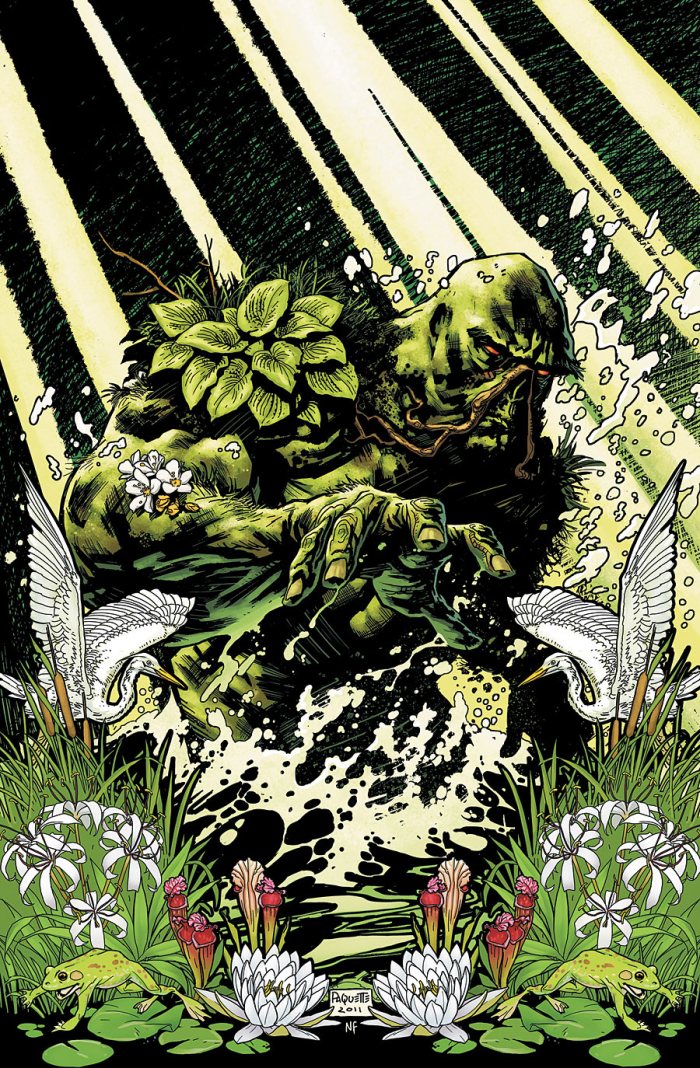Welcome back once again to my annual countdown of my favourite comics from the year that was. You might have noticed that while on the previous three occasions I’ve ran this countdown on my blog the list has been a Top 10, this time round it’s been expanded to a Top 20. And that is testament to how much of a truly spectacular year 2013 has been for comics. There has been a wealth of fantastic new titles launched over the past 12 months, while established books have gone from strength to strength, and we’ve even seen a few comics that had been on the decline finding a new lease of life to blast them back onto the radar. There were so many quality comics that it didn’t feel fair to just put a spotlight on the best 10 this year. Indeed, it proved to be a struggle narrowing the list down to a top 20, even! 2013 has been a banner year for comics. At this point I tend to talk a little about how my own reading habits have shifted in the intervening year. Last year I talked about Image being on the rise, and that trend has continued in 2013, with Marvel and DC all but dropping off the map in my weekly comics haul while more and more Image titles get added to the point where they now utterly dominate my monthly reading. A reminder of my rules for eligibility: the comic has to either be a graphic novel/oneshot released in 2013, or an ongoing/miniseries that has had 3 or more issues released in 2013 at the time of writing. This means that while the likes of Velvet, Pretty Deadly, Drumhellar and The Sandman: Overture had stellar first issues, none of them have had enough issues for them to qualify. Perhaps they’ll show up on next year’s list! Finally, I should point out this is the first year I’ve done the list that Scalped wasn’t in contention, having finished last year, so that top spot is WIDE OPEN! Who’ll be #1 of 2013? Read on and see…
20. SWAMP THING
Swamp Thing is a title that suffered from something of a steep fall from grace. I remember way back when issue #1 hit as part of DC’s New 52 launch, written by Scott Snyder and drawn by Yanick Paquette, I declared it the best of all DC’s new #1s. But going into the “Rotworld” storyline I felt the quality slip a little, and so I had resigned myself to likely dropping the title after Snyder’s departure, only deciding to give incoming writer Charles Soule a go for an issue to confirm my decision. Boy was I wrong! Charles Soule, working mostly with artists Kano and Jesus Saiz on rotation, has knocked this title out of the park since coming onboard, utterly reinvigorating the series and giving it a bold new direction and sense of forward momentum. Rather than trying to ape Snyder’s style, Soule is doing his own thing here, returning Swamp Thing to more of a pulpy superhero aesthetic, and letting Swamp Thing make some cool, inventive uses of his plant powers. Every month, Soule does something new to impress me. First, he’s gifting Alec Holland with a natural, relatable voice through his narration. Then, he’s finding fresh wrinkles in the history of The Green to expand and enrichen Swamp Thing’s mythology. Then he utterly leaves the rest of the Villain’s Month oneshots in the dust with a tale that succeeds in making Anton Arcane skin-crawlingly scary again. Now, with this current story featuring Swamp Thing battling Jason Woodrue over The Green’s avatar mantle, he’s hitting us with some of the most nail-biting cliffhangers and shock reversals of Big Two comics. Meanwhile, Kano and Saiz carry on the tradition of Wrightson, Bissette, Veitch and Paquette with their flair for visual innovation, crafting awe-inspiring page compositions. I’ve said it before, and I’m not the only one to make the comparison, but for me, Swamp Thing has become DC’s answer to Mark Waid and Chris Samnee’s Daredevil, in the way it can feel both like an homage to all that’s come before and a fresh new start unburdened by the darkness of past storylines, and is just pure, exhilarating fun. Those who did drop the comic after Scott Snyder left are missing out!
19. CHEW
Chew continues to see-saw in and out of my top 10. As I said last year, it’s not really a reflection on the quality of the title, which has remained consistently entertaining and laugh-out-loud funny, but more on the emergence of hot new titles vying for attention. It’s interesting, because I can remember when Chew was the new kid on the block, arguably the first in that new wave of white-hot Image issue #1 buzz-books, and now it has reached the point where it is a most venerable stalwart of the Image lineup, several years and nearly 40 issues into its run. I think one factor in its slip down the rankings this year is that it feels like there have been a lot of occasions where the wait between issues has been a good bit longer than a month. I seem to be going through this pattern lately of getting the new issue of Chew when it comes out, and not being able to really recall what happened in the previous issue, and taking a while to getting round to read this latest one. But then when I finally do sit down to read the new issue, I immensely enjoy it and feel keen to get to the next chapter. And then the cycle repeats itself. So, Chew might be in need of a little extra spark to reassert itself up amongst the best of the best in Image’s ever-growing lineup, but it’s definitely not in any danger of being dropped, as John Layman and Rob Guillory continue to deliver a comic packed with delicious goodness.
18. STRANGE ATTRACTORS
Charles Soule again, this time paired up with Greg Scott in this delightfully smart and inventive comic from Archaia. This was one of my best purchases from New York Comic Con, with Archaia’s typically superb production values making it a beautiful hardcover graphic novel package. Strange Attractors tells the story of bright academic Heller Wilson becoming the protégé of aging genius/eccentric Dr. Spencer Brownfield, who may or may not have spent the past 30 years secretly keeping New York City running through the power of super-maths. It’s a masterfully-structured tale, the various narrative threads weaving together like strands of a complex equation. There’s an ominous air of impending doom hanging over much of the story as it steadily moves forward, quietly immersing you, but the end result is surprisingly inspirational and upbeat. A highly potent love letter to New York City, and one that certainly made me miss it, having read this shortly after returning home to Scotland. This year has really seen Charles Soule mark himself out as a real writer of note, and I for one am keen to see what he has lined up for 2014.
17. SHELTERED
If you’d told me that Lazarus wouldn’t make my top 20 list back when I read issue #1, I’d have laughed you out of the room. I remember being hugely impressed back when I read the first issue of that new series, thinking this was sure to be one of the standout debuts of the year… then a week later Sheltered came along and trumped it. Sheltered #1 was just a textbook example of how to grab readers by the proverbial baw-hairs and DEMAND their attention and continued reading, with Ed Brisson evocatively building up a well-realised status quo and ruthlessly tearing it down all in the space of a single comic book. Out of the ashes of that devastation has risen a tense, haunting tale about children forced to become adults and largely failing at the task, and a harsh study of survival and evil. And the art of Johnnie Christmas and colours of Shari Chankhamma give the whole thing an ethereal, dreamlike aesthetic, a work of strange, glacial beauty that creates an interesting contrast with some of the horrific things that happen within these pages. There are many ways Sheltered could go from here, but at this point it has all the makings of a 21st Century Lord of the Flies.
16. GHOSTED
I’m sure I’ll be writing similar notes throughout this list, but it says something about the incredibly high standard of comics output in 2013 that Ghosted places where it does. Earlier drafts of this list had both this and Sheltered secure in the top 10. But rest assured, this is more a reflection on the superlative quality of the year’s books than any slight on Ghosted, a delightfully inventive genre mash-up. Joshua Williamson’s irresistible “I wish I’d done it first” concept is to mix the classic heist story with the haunted house genre, with our protagonist Jackson T. Winters assembling a crack team of criminal experts for a daring robbery, not to steal money or diamonds, but to steal a ghost from a notorious murder house. It seemed like a delicious hook for a miniseries, so pure and self-contained. But the latest issue wonderfully opened up the idea into a bigger world and set the stage for how Williamson’s high-concept could sustain an ongoing. Though I worry for how the next arc will fare without the indelible contribution of artist Goran Sudzuka, who in 5 issues has excelled in crafting a slick, cool signature style for the book. Still, the series is off to a strong start, and I’m keen to see what happens next.
15. INFINITY
I had largely sworn off the big Marvel/DC event crossovers. I gave up on Fear Itself, disregarded Brightest Day, skipped Flashpoint, passed on Avengers VS X-Men, ignored Age of Ultron, dismissed Trinity War. Not since 2010’s Siege had I read an event in its entirety. But this year has proven to be something of a vintage year for events. DC’s offering, Forever Evil, has thus far proved pretty enjoyable, though it didn’t quite make the cut for this list. Marvel, meanwhile, gave us Infinity, a comic I almost never read due to all the talk about how it was impossible to read without a detailed knowledge of Jonathan Hickman’s entire Avengers and New Avengers runs or without buying the tie-ins in those respective books: as a rule of thumb I never buy tie-ins outwith the core event title that I supposedly “have” to read. But on a whim one day I bought and read the first 5 issues of Infinity and was utterly engrossed, and more recently the 6th and final chapter brought it all home nicely. You can absolutely enjoy this story without the tie-ins, though I’m sure they make it richer. This is an event story that actually feels like an event, with Hickman generating an epic, sweeping tone and a grandiose scale. The combined threat of the Builders to the galaxy as a whole and Thanos to Earth in particular creates a sense of seemingly insurmountable adversity, making it all the more awesome when The Avengers triumph in the face of it. Thor gets one of his most badass moments ever. An ultimate underdog fight between Black Bolt and Thanos is set up so powerfully that I was made into a fan of the Inhumans. Various characters I’d never heard of before were presented as major players who I’m now invested in learning more about. And the finale managed to both provide a satisfying resolution and set the seeds for numerous storylines that will likely be picked up on down the line in Hickman’s various Avengers titles, as opposed to just being an advertisement for the next event. Easily the best crossover event from either company in years, and a shining example of how it should be done.
14. THE WALKING DEAD
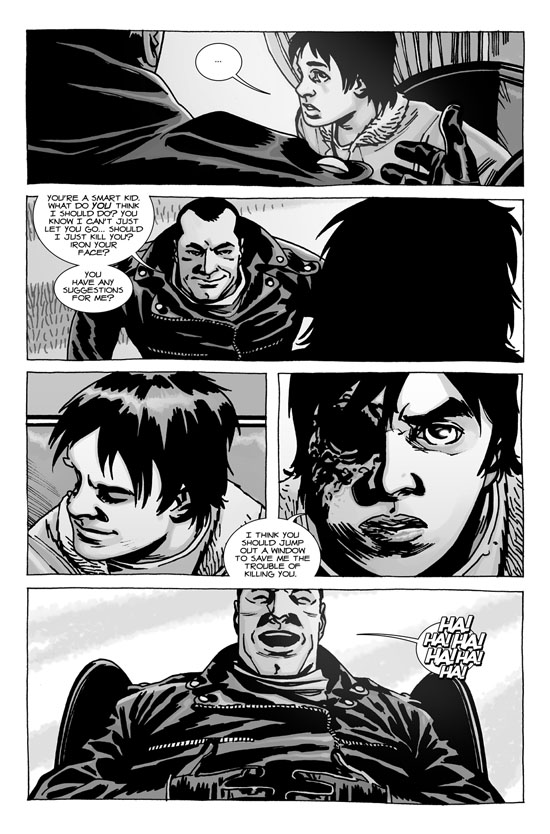 What a decline The Walking Dead has suffered in my estimations over the years! After ranking near the top of my list in 2010, it dropped off the top ten in 2011, and by early 2012 I was beginning to question if I was just buying the book out of habit and whether or not I should just drop it. But issue #100 marked a major turning point for the series, reinvigorating Image’s most famous series and giving it a compelling new direction that saw the title on an upward curve throughout the rest of 2012. That trend has continued into 2013, with Robert Kirkman and Charlie Adlard’s zombie opus now the best it’s been in years. And a big part of that is down to the new Big Bad, Negan. A lot of people argue the series was at its absolute best during the Governor/Woodbury saga (I disagree, personally identifying the period immediately after the departure from the prison, up to and including the “Fear the Hunters” arc as the best, though the Governor stuff comes close), and that the loss of momentum has been due to the lack of a similarly formidable villain. Well, now Negan has truly filled that void. He’s a suitably different beast to The Governor too, with a twisted code of ethics and dark sense of humour that has at times even made him weirdly likeable: who thought I’d go from instantly wanting him dead in issue #100 to ranking him as one of my favourite characters? I still want him to get his comeuppance, though. The series is going from strength to strength with the way it has built up this new, wider world for Rick, Carl, Michonne and co to exist in, and with the 10th Anniversary “All Out War” storyline already proving explosive, it seems things are set to get even better!
What a decline The Walking Dead has suffered in my estimations over the years! After ranking near the top of my list in 2010, it dropped off the top ten in 2011, and by early 2012 I was beginning to question if I was just buying the book out of habit and whether or not I should just drop it. But issue #100 marked a major turning point for the series, reinvigorating Image’s most famous series and giving it a compelling new direction that saw the title on an upward curve throughout the rest of 2012. That trend has continued into 2013, with Robert Kirkman and Charlie Adlard’s zombie opus now the best it’s been in years. And a big part of that is down to the new Big Bad, Negan. A lot of people argue the series was at its absolute best during the Governor/Woodbury saga (I disagree, personally identifying the period immediately after the departure from the prison, up to and including the “Fear the Hunters” arc as the best, though the Governor stuff comes close), and that the loss of momentum has been due to the lack of a similarly formidable villain. Well, now Negan has truly filled that void. He’s a suitably different beast to The Governor too, with a twisted code of ethics and dark sense of humour that has at times even made him weirdly likeable: who thought I’d go from instantly wanting him dead in issue #100 to ranking him as one of my favourite characters? I still want him to get his comeuppance, though. The series is going from strength to strength with the way it has built up this new, wider world for Rick, Carl, Michonne and co to exist in, and with the 10th Anniversary “All Out War” storyline already proving explosive, it seems things are set to get even better!
13. FATALE
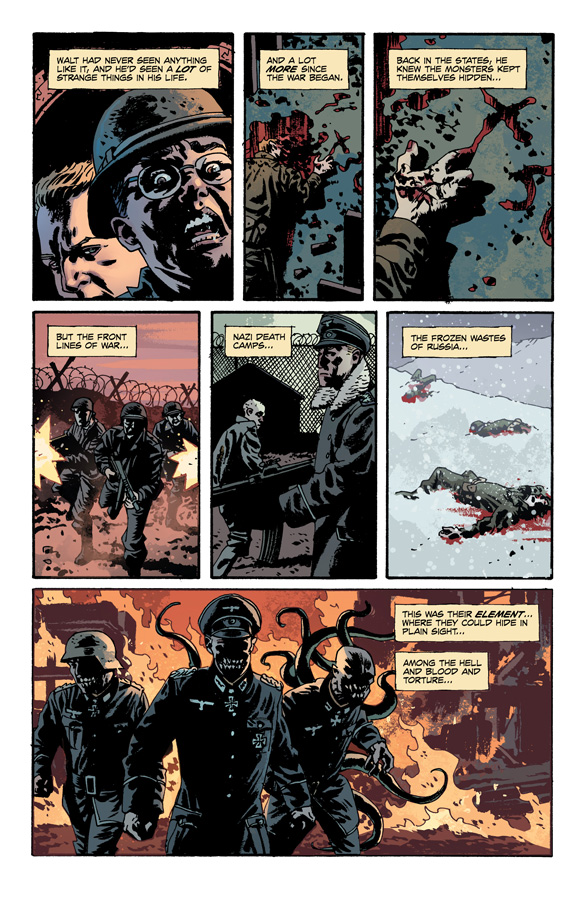 Another comic to go from strength to strength this year, Fatale was always an interesting series, but one that very much went for the slow-boil approach. But with its past couple of arcs, Ed Brubaker and Sean Phillips’ blend of noir and Lovecraftian horror has really started to turn up the heat. First, a collection of standalone issues from various periods in history served to expand the mythos of the series in fascinating ways. And now, Fatale has soared to new heights with this current storyline, with the timeline jumping forward to the indie music scene of the early 90s, and a disquieting moral fable that has served to crystallize the haunted tragedy, the irresistible allure and the poisonous influence of our mysterious protagonist Josephine more compellingly than any other storyline in the title up until now. Up until now we’ve been told how all men fall for her and find themselves obsessing over her, but this story has truly immersed us in this happening and made us believe it. With the way Brubaker and Phillips has introduced this poignantly human cast of characters and systematically destroyed them reminds me of the classic “24 Hour Diner” issue of The Sandman with Dr. Destiny. Fatale as a series continues to evolve and improve, while this arc in particular stands as the best single thing Brubaker and Phillips have done since Criminal: Last of the Innocent.
Another comic to go from strength to strength this year, Fatale was always an interesting series, but one that very much went for the slow-boil approach. But with its past couple of arcs, Ed Brubaker and Sean Phillips’ blend of noir and Lovecraftian horror has really started to turn up the heat. First, a collection of standalone issues from various periods in history served to expand the mythos of the series in fascinating ways. And now, Fatale has soared to new heights with this current storyline, with the timeline jumping forward to the indie music scene of the early 90s, and a disquieting moral fable that has served to crystallize the haunted tragedy, the irresistible allure and the poisonous influence of our mysterious protagonist Josephine more compellingly than any other storyline in the title up until now. Up until now we’ve been told how all men fall for her and find themselves obsessing over her, but this story has truly immersed us in this happening and made us believe it. With the way Brubaker and Phillips has introduced this poignantly human cast of characters and systematically destroyed them reminds me of the classic “24 Hour Diner” issue of The Sandman with Dr. Destiny. Fatale as a series continues to evolve and improve, while this arc in particular stands as the best single thing Brubaker and Phillips have done since Criminal: Last of the Innocent.
12. ZERO
Zero is an interesting comic, in that it seemed to be under the radar for quite a while, then all of a sudden it picked up a lot of buzz as the release of the first issue drew near. Much was made of the innovative approach to the series, which would see writer Ales Kot tell ostensibly done-in-one standalone tales with the eponymous hero, super-spy Edward Zero, with a different artist illustrating each story. It’s a great concept, one that made me give the series a try, but I was thrilled to discover that the execution was even better. In the three issues released thus far, artists Michael Walsh, Tradd Moore and Mateus Santalouco have all delivered some stunning imagery, their disparate styles unified by the majestic colours of Jordie Bellaire. Ales Kot, who has shown creative promise with the likes of Wild Children and Change, here delivers his most accomplished work to date, taking that supposedly episodic framework and in fact crafting an intricately connected narrative tapestry, which we’re uncovering out of chronological order, but which I feel is going to take shape into an immensely compelling whole, once the series has been given more time to unfold. If Zero continues to build momentum the way it has this early in its run, look at it as a serious contender to leap into the top 10 on next year’s list.
11. DUNGEON FUN
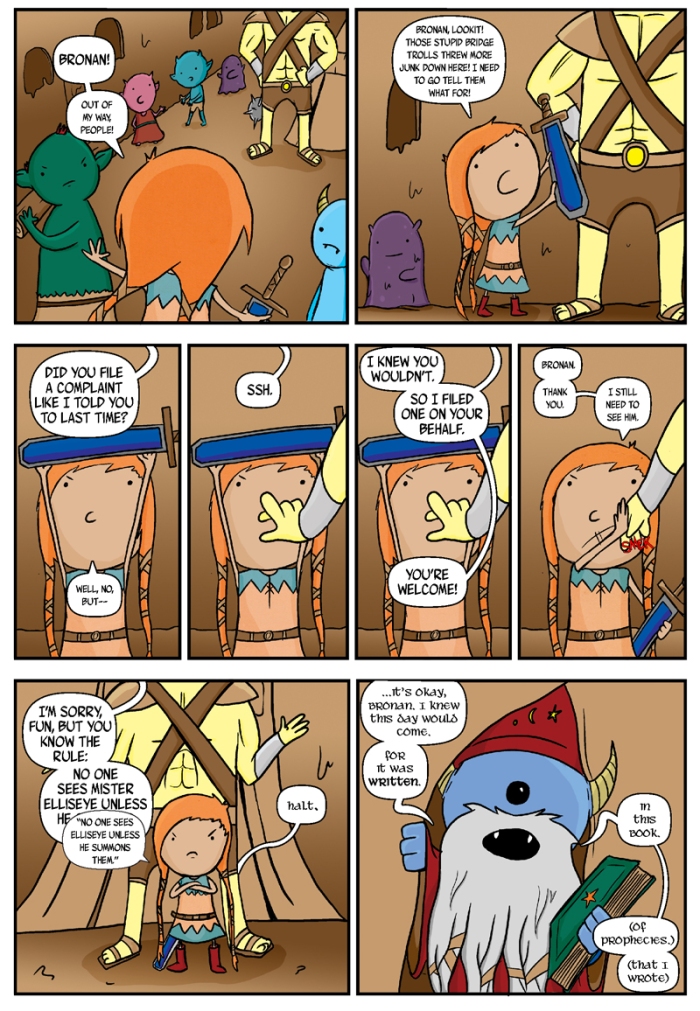 Okay, this one is a bit of a cheat. As I mentioned in my intro at the top, the usual perimeters for eligibility on this list include either being a graphic novel/oneshot, or in the cases of ongoings/miniseries’, that 3 or more issues were released in the contended year. Dungeon Fun only had one issue released. And given that I usually enforce this rule so rigorously, even cutting out MonkeyBrain’s Bandette from inclusion of an earlier draft of my list once I realised only two issues had been released this year, a book has to be pretty special to supersede it. With Dungeon Fun, there are a couple of mitigating factors. For one, small press titles work on a very different schedule than something released monthly or bi-monthly through Diamond, and in many cases it’s unreasonable for such books to have more than three issues within a year. But more pressingly, it’s just too damn good to ignore. A delightful fantasy romp that has rode a veritable tidal wave of critical adulation here in the UK, drawing comparisons to such diverse inspirations as Monty Python, Adventure Time, The Princess Bride and the Legend of Zelda games, Dungeon Fun is truly “all ages” not in the patronising, ghettoised “Y’know, for kids!” way some interpret it, but in the sense that it can capture the imaginations of audiences of all ages. The wonderful artwork of Neil Slorance is brimming with energy and imagination, projecting this sense of fun and accessibility, and I was able to see first-hand on the convention floor how kids gravitated towards this book and eagerly grabbed a copy. And the grown-ups can appreciate the razor-sharp wit of Colin Bell’s script, packing laugh-out-loud gags with a density approaching Airplane levels. This is a book that lives up to its title, as in terms of pure FUN there’s not a single comic released this year that was able to leave a smile on my face as big as Dungeon Fun #1 did. I know that last year, quite a few people picked up Iain Laurie’s Horror Mountain on the basis of my recommendation in my year-end list, so I can only say that this book comes just as heartily recommended. Get your copy here: https://sellfy.com/p/3EZi/.
Okay, this one is a bit of a cheat. As I mentioned in my intro at the top, the usual perimeters for eligibility on this list include either being a graphic novel/oneshot, or in the cases of ongoings/miniseries’, that 3 or more issues were released in the contended year. Dungeon Fun only had one issue released. And given that I usually enforce this rule so rigorously, even cutting out MonkeyBrain’s Bandette from inclusion of an earlier draft of my list once I realised only two issues had been released this year, a book has to be pretty special to supersede it. With Dungeon Fun, there are a couple of mitigating factors. For one, small press titles work on a very different schedule than something released monthly or bi-monthly through Diamond, and in many cases it’s unreasonable for such books to have more than three issues within a year. But more pressingly, it’s just too damn good to ignore. A delightful fantasy romp that has rode a veritable tidal wave of critical adulation here in the UK, drawing comparisons to such diverse inspirations as Monty Python, Adventure Time, The Princess Bride and the Legend of Zelda games, Dungeon Fun is truly “all ages” not in the patronising, ghettoised “Y’know, for kids!” way some interpret it, but in the sense that it can capture the imaginations of audiences of all ages. The wonderful artwork of Neil Slorance is brimming with energy and imagination, projecting this sense of fun and accessibility, and I was able to see first-hand on the convention floor how kids gravitated towards this book and eagerly grabbed a copy. And the grown-ups can appreciate the razor-sharp wit of Colin Bell’s script, packing laugh-out-loud gags with a density approaching Airplane levels. This is a book that lives up to its title, as in terms of pure FUN there’s not a single comic released this year that was able to leave a smile on my face as big as Dungeon Fun #1 did. I know that last year, quite a few people picked up Iain Laurie’s Horror Mountain on the basis of my recommendation in my year-end list, so I can only say that this book comes just as heartily recommended. Get your copy here: https://sellfy.com/p/3EZi/.
10. THOR: GOD OF THUNDER
And while we’re talking about “books that would have ranked if only 3 issues had been released in the year” scenarios, in last year’s 2012 top ten, Thor: God of Thunder #3 came out about a week after I posted up my list. And that’s a shame, as if that issue had come out sooner (or the list had gone up later), based on the immense quality of those first three issues, Thor: God of Thunder would very likely have broken my top 5. Fast forward a year, and again I find myself talking about the intense competition and insanely high quality of 2013’s output having some great titles ranking lower than I expected. But this shouldn’t be read as any decline in quality from Scalped writer (and perennial favourite of this annual year-end countdown) Jason Aaron’s take on Thor: this remains, in my opinion, Marvel’s best title. The epic 11-chapter “God Butcher” saga that dominated the first year of the series was Thor’s answer to Batman’s “Court of Owls” epic, in how it used the introduction of a deadly new enemy to dig into its iconic hero’s history, push them to the brink of defeat and despair, and ultimately have them kick mega ass. And Esad Ribic further demonstrated why he’s one of my absolute favourite artists with breathtaking visuals and a magnificent design for villain Gorr. We then got a pensive, poignant oneshot exploring Thor’s place as a hero, a god and a man in the modern world, before Ron Garney stepped in on art duties for the currently-ongoing storyline, “Accursed”, which has presented a Malekith far more formidable than his cinematic counterpart, and presented a tale by turns funny, dramatic, and strangely relevant as a parable of the nature of war and military intervention in the real world. With next year promising the return of Esad Ribic, Thor: God of Thunder should continue to be Marvel’s MVP well into 2014.
9. FIVE GHOSTS
Over the past year or so, I’ve seen talk about how Image is too big now, how it’s become a playground for famous, established names in the comics field to bring their creator-owned properties to, and thus it’s lost its status as the publisher that gives a platform to exciting new creators. But then something like Five Ghosts comes along and reaffirms Image’s status as a launching pad for the next generation of comics stars. Though both do have credits to their name, writer Frank J Barbiere and artist Chris Mooneyham could still be considered newcomers to the wider comics stage, and yet they delivered one of the best Image series launches of a year filled with them. An ode to pulp adventure spliced with a hearty dose of Gothic horror, Five Ghosts introduces us to Fabian Gray, an explorer whose encounter with an artefact known as the Dreamstone has left him with the ability to channel the abilities of five literary spirits. Cue some relentlessly paced adventure courtesy of Barbiere’s brisk, action-packed scripts, while Chris Mooneyham has emerged as one of the breakout artists of 2013 with his luscious, evocative visuals that hark back to classic comics of the 70s and 80s. Five Ghosts began life as a miniseries, but it’s no surprise it got promoted to ongoing status. No one could have read those stellar first 5 issues and not wanted more of this character and this world. After an enjoyable fill-in issue skilfully illustrated by Garry Brown, Barbiere and Mooneyham are back in the saddle for a second arc that seems set to draw in the swashbuckling pirate adventure into its melting pot of pulp homage. And if all that wasn’t enough to cement its place in my top 10, each issue of Five Ghosts now comes with added Doc Unknown: the similarly pulp-infused comic from Fabian Rangel Jr and Ryan Cody almost made the top 20 in its own right, and is now a regular backup feature in Five Ghosts. This title is a joy to read, and from pointing it out to people at my local comic shop to giving copies of the Haunting of Fabian Gray graphic novel out as Christmas gifts, I have and will continue to spread the word to those I know that Five Ghosts is worth your attention.
8. THE PRIVATE EYE
The Private Eye caught a lot of people on the back-foot. One day, sites began running teaser images of a mysterious new comic from writer Brian K Vaughan and artist Marcos Martin. What could it be? Who would be publishing it? Many of us were preparing ourselves for months of tantalising teasers leading to a big release from someone like Image, but the very next day, The Private Eye launched online, self-published by Vaughan and Martin under their Panel Syndicate imprint, going under a “pay what you want” system, with downloading a digital copy of the comic for free an option. I’ve bought each issue for $2.99, as it’s easily worth that. There are few people in comics that do an issue #1 better than Vaughan, and The Private Eye continued that tradition, giving us a dystopian/utopian vision of a future where there is no internet, where in place of online identities people walk around with literal masks to craft their own personas, and the media has become the most powerful law enforcement entity on the planet. Enter paparazzi/private investigator P.I., and we’re thrown into a futuristic take on a classic, pulpy gumshoe noir. We’ve had 4 issues thus far, and equally recommended is the special “making of” comic released that delved into the process of creating this comic from the ground up. Reading this gives you a strong idea of just how centrally involved artist Marcos Martin was in the building of this world and the telling of this story, his vision for the world so integral to the success of the story that his absence is unimaginable. I’ve read quite a few quality digital comics this year, with MonkeyBrain’s output in particular proving consistently entertaining. But The Private Eye stands as the cream of the crop.
7. NOWHERE MEN
 Here’s an entry that threw a spanner in the works. Before heading down to Thought Bubble last month, I thought I had my top 20 pretty much figured out. I still needed to shuffle around the ordering here and there, but the actual content of the list seemed to be finalised. But then I bought the first graphic novel collection of Nowhere Men at the show, and decided to read it on the train home to Glasgow… I ended up devouring the whole book in a single frenzied sitting during the journey. I immediately wanted it in the top 20, popping it in at the bottom spot: this is what finally chopped Lazarus off the list, I’m afraid! But upon going back to the book and rereading parts, I just fell in love with the craft of the thing more and more, and it steadily climbed up and up in my rankings until it reached the slot it’s at now, and even then I flirted with the notion of putting it higher. The best comics don’t just tell a story, they create a world for the reader, and that’s what writer Eric Stephenson does with Nowhere Men. The audacious level of ambition on display here is thrilling, as over the course of the first 6 issues he crafts a tale juggling multiple narrative threads, spanning across multiple generations, and a cast of over a dozen principal players. It could easily have ended up a train wreck, but Stephenson orchestrates it all with panache, crafting a rich, nuanced alternate history of the world where science had the same kind of pop culture boom that rock-and-roll did in the 1960s, complete with its own answer to The Beatles in the form of the founding members of science dream team World Corp. It’s a mythology made all the more immersive by the comic’s innovative use of posters and archival newspaper and magazine articles peppered within the comic narrative to flesh out the shape of the world between that pivotal era in the ‘60s and our vastly altered present. The series as a whole really is a triumph of design, with the team of artist Nate Bellegarde and colorist Jordie Bellaire bringing superheroic flair to the world of cutting-edge science. Read Nowhere Men, and you really will buy into its central notion that “science is the new rock ‘n’ roll.”
Here’s an entry that threw a spanner in the works. Before heading down to Thought Bubble last month, I thought I had my top 20 pretty much figured out. I still needed to shuffle around the ordering here and there, but the actual content of the list seemed to be finalised. But then I bought the first graphic novel collection of Nowhere Men at the show, and decided to read it on the train home to Glasgow… I ended up devouring the whole book in a single frenzied sitting during the journey. I immediately wanted it in the top 20, popping it in at the bottom spot: this is what finally chopped Lazarus off the list, I’m afraid! But upon going back to the book and rereading parts, I just fell in love with the craft of the thing more and more, and it steadily climbed up and up in my rankings until it reached the slot it’s at now, and even then I flirted with the notion of putting it higher. The best comics don’t just tell a story, they create a world for the reader, and that’s what writer Eric Stephenson does with Nowhere Men. The audacious level of ambition on display here is thrilling, as over the course of the first 6 issues he crafts a tale juggling multiple narrative threads, spanning across multiple generations, and a cast of over a dozen principal players. It could easily have ended up a train wreck, but Stephenson orchestrates it all with panache, crafting a rich, nuanced alternate history of the world where science had the same kind of pop culture boom that rock-and-roll did in the 1960s, complete with its own answer to The Beatles in the form of the founding members of science dream team World Corp. It’s a mythology made all the more immersive by the comic’s innovative use of posters and archival newspaper and magazine articles peppered within the comic narrative to flesh out the shape of the world between that pivotal era in the ‘60s and our vastly altered present. The series as a whole really is a triumph of design, with the team of artist Nate Bellegarde and colorist Jordie Bellaire bringing superheroic flair to the world of cutting-edge science. Read Nowhere Men, and you really will buy into its central notion that “science is the new rock ‘n’ roll.”
6. SEX CRIMINALS
 There are certain times when you know you’ll love a comic as soon as you hear its name. Such was the case with Sex Criminals. And I was won over even more when I heard of the high concept behind the series: two people with the power to stop time with their orgasms go on a crime spree. So, I went into this comic pretty giddy with anticipation, and still managed to be disarmed by how great it was. I think what took me by surprise is that, though a book like this could have easily just coasted on that central concept and been a whole barrel of fun, it’s instead done something much more. Over the course of the first three issues, it has managed to craft a genuinely sweet account first of the experience of growing up and discovering your sexuality as a girl, through the heightened prism of our narrator Suzie discovering her powers, then of a boy’s experience of sexual awakening through the story of Jon, then the joy and thrill of beginning a new relationship. And save for the odd flash-forward, we haven’t even got to the “criminals” part of the title yet! Reading the phenomenal letters page just confirms the chord these issues have struck with real life experiences of the readers. And on top of all that, it’s genuinely hilarious, with artist Chip Zdarsky utterly cramming the comic full of brilliant sight gags. Matt Fraction has been on a real roll lately, but Sex Criminals could very well be the best thing he’s ever written. Perhaps the only thing preventing it from breaking the top 5 is that, three issues in, I need to read some more to see if the dizzyingly high pace can be sustained over the long term. Next year’s list will tell the tale!
There are certain times when you know you’ll love a comic as soon as you hear its name. Such was the case with Sex Criminals. And I was won over even more when I heard of the high concept behind the series: two people with the power to stop time with their orgasms go on a crime spree. So, I went into this comic pretty giddy with anticipation, and still managed to be disarmed by how great it was. I think what took me by surprise is that, though a book like this could have easily just coasted on that central concept and been a whole barrel of fun, it’s instead done something much more. Over the course of the first three issues, it has managed to craft a genuinely sweet account first of the experience of growing up and discovering your sexuality as a girl, through the heightened prism of our narrator Suzie discovering her powers, then of a boy’s experience of sexual awakening through the story of Jon, then the joy and thrill of beginning a new relationship. And save for the odd flash-forward, we haven’t even got to the “criminals” part of the title yet! Reading the phenomenal letters page just confirms the chord these issues have struck with real life experiences of the readers. And on top of all that, it’s genuinely hilarious, with artist Chip Zdarsky utterly cramming the comic full of brilliant sight gags. Matt Fraction has been on a real roll lately, but Sex Criminals could very well be the best thing he’s ever written. Perhaps the only thing preventing it from breaking the top 5 is that, three issues in, I need to read some more to see if the dizzyingly high pace can be sustained over the long term. Next year’s list will tell the tale!
5. BATMAN
With the ascension of Image Comics, and how (as can be seen by the quantity of their titles to make my list) the vast majority of my monthly reading now seems to be their output, I have considered the possibility of me at some point dropping Marvel and DC entirely. Could I reach a point where all my favourite creators are doing by far their best work in Image or for other independents, to the point where I feel like I no longer need my superhero fix? I may have mulled over this hypothetical future briefly, but in truth, so long as there are comics as excellent as Scott Snyder and Greg Capullo’s Batman out there, I will always remain a fan of superhero comics. For me, saying “I refuse to read superhero comics” is as limiting as saying “I will only read superhero comics.” I will read what entertain me the most, and what I feel are the best comics, period, and Batman is serialised comics storytelling at its finest, by any standard. It had a slight wobble at the start of the year. As much as I loved “Death of the Family”, the very last chapter didn’t quite stick the landing for me as much as I’d hoped. Then we had a few more low-key issues that, while entertaining in their own right, didn’t live up to the title at its exhilterating best. And, as I’ve mentioned before, I hated the concept of “Zero Year” when I first heard it. But execution is everything, and with one of the finest creative pairings in comics today at the helm, I feel like a fool for ever doubting. “Zero Year” has been utterly remarkable, with Greg Capullo crafting some of his best artwork yet; really pushing the boundaries and getting increasingly experimental with his layouts and innovations. And Scott Snyder has skilfully found new wrinkles in the Batman mythos, and ways of making Batman’s well-worn early years feel fresh and dangerous. One of the big secrets of this title’s continued to success is that, at its core, Snyder has made it a Bruce Wayne character study, with each major arc picking apart a different weakness, bringing out the vulnerability in a character all too often presented as invincible. In this character-driven approach to its iconic hero, I think people are perhaps misguided in comparing “Zero Year” to Year One. If anything, it’s Batman’s answer to Birthright. For the third year running, Batman closes the year out as not only the biggest, but also the best superhero comic currently on the shelves.
4. SAGA
Woe betide poor Saga! Last year was the closest-fought battle for the #1 spot I’ve ever had in trying to decide between the top two entries in my year-end list. In the end, Jeff Lemire’s instant classic The Underwater Welder only just squeezed past Saga to top my list of the best comics of 2012. But I took heart in thinking that Saga was in for the long haul, and was all but guaranteed to top this year’s list. I had it pencilled in for the #1 spot from January. But over the course of this year, sadly, I feel like the mighty Saga lost a step. Only a step, mind, but even that slight faltering, combined with the massive impression made on me by the three remaining entries on the list, were enough to have that prized #1 slot slip from Saga’s fingers once more. I think its downfall was that a lack of forward motion or a sense of urgency in the plot, particularly in this current third arc. I do feel like the ending of this most recent issue signals that the proverbial shit is about to hit the fan and things are really going to start moving, but up until now it feels like much of the narrative progression has ground to a halt in favour of just hanging out with the characters and getting inside their heads a bit more. This would be a bigger problem for most books, but thankfully Saga happens to have some of the best characters in comics, and so hanging out with them is a joy in of itself. Because while I may bring up the concerns about pacing, I’m almost not bothered about the wider story of the intergalactic war going on, as I’m so engrossed with what Marco, Alana, Prince Robot IV, The Will, Lying Cat et al are up to, the interesting conversations about life and love they’re having. I’ve actually got a sneaking suspicion that Brian K Vaughan is in fact trying to stealthily get us into an intimate family drama about what it means to be a parent and to be a child, about the families we’re both born into and that we make for ourselves, and he just cleverly disguised it as a sweeping sci-fi/fantasy epic. His cast are so fully realised that I already feel like I know them, and so it’s extra devastating when any of them die, or even placed in mortal danger. And what can be said about Fiona Staples that hasn’t already been said? In her tenure on this title, she has evolved into one of the premier artists in comics, and each issue is packed with more beautiful imagery and masterful characterisation. This is true superstar work, and her work here has secured her spot on the comic artist A-list for years to come. It’ll be interesting to see how Saga fares next year. Will it go down the list if the pace continues to frustrate? Or will it go up the rankings if the plot kicks into motion, or if I more fully embrace the narrative working on a whole other level than what I’d perhaps originally anticipated? Perhaps next year it might even claim that elusive #1 spot?
3. THE WAKE
Surprisingly, Batman is not the highest-ranked Scott Snyder comic on my list. No, that accolade goes to The Wake, his collaboration with artist Sean Murphy. With American Vampire spending most of this year in hiatus, The Wake was left to fill the void in Snyder Vertigo output, and it instantly became the imprint’s standout title for the bulk of 2013. Channelling the likes of Alien and The Thing, The Wake tells the story of marine biologist Lee Archer, taken down to a secret base at the bottom of the ocean with various other aquatic experts, where they quickly end up stranded and pitted against monstrous creatures from the black depths below. I think there is something inherently alien and frightening about the deep, deep sea, and Sean Murphy’s visuals here prove utterly masterful at capturing that sense of isolation and claustrophobia. I first became a fan of his on American Vampire: Survival of the Fittest, and what I’ve seen of Punk Rock Jesus is very impressive, but this is Murphy’s most accomplished work yet, true auteur stuff. Snyder, meanwhile, managed to craft a narrative packed with tension, shock reversals and genuine frights, but his most audacious move has come at the halfway point, which we’ve now reached as the year comes to a close. If The Wake had just been a 5-part miniseries about this horrific ordeal experienced by this ensemble of characters we come to care about in their deep sea base, it would have been considered a home run success as an intimate, tightly-contained thriller. But Snyder is instead doing something much more ambitious, weaving vignettes of the distant past and the impending apocalyptic future through the narrative, and setting the stage for the second phase of the series, which promises to explode open the scope of the story into a tale of global dystopia in a catastrophic future where the siege of phase one has escalated into all-out war for the future of mankind. It’s risky, as if it doesn’t work the whole thing could collapse. But if he pulls it off, it’s going to be spectacular. When it’s all said and done, I can see The Wake standing as a trademark comic for both Snyder and Murphy: when it’s all collected in a lovely hardback, that’s always going to be a hot seller. And I can already see The Wake being a hit movie in a few years. But that might be getting ahead of ourselves. First, let’s see if issues #6-#10 can be executed as note-perfect as issues #1-#5 were. With the talent involved, I’m confident!
2. EAST OF WEST
It’s strange seeing East of West ranked above Saga, considering back when East of West #1 came out I wrote I talked about the parallels between the two titles, and how I felt that Saga #1 did a better job of introducing its world. In fact, I didn’t warm to East of West right away, originally dropping it after issue #2, so I remained vocal in my affirmation that Saga was the superior series. But I continued to hear good things about East of West, so I ended up getting the first graphic novel around the time issue #6 came out to give it another try. As it turns out, I was a fool. A blind fool! Something just clicked for me on repeat reading, and I fell in love. Really, the comparisons with Saga only work on the barest of surface levels, as this is ultimately a different beast. Saga is using the backdrop of a massive, epic intergalactic war to tell a very small, intimate, personal story about a family’s struggle for survival. East of West is telling a massive, epic story that’s staggering in scale, so much so I feel like even now we’ve yet to taken in the full scope of its multi-pronged narrative. It’s a story so big I don’t think I can do it justice in this paragraph, but basically it’s about an alternate history of America, one where the Civil War went a different way and ended up with America divided into 7 nations, and our story begins with the time drawing near where the Four Horsemen are destined to bring about the end of the world. Only one of them, Death, has his own agenda, one that involves getting revenge on those who wronged him and reclaiming a lost love. Each issue is an exercise in giving us a piece of the puzzle, unlocking another part of this sprawling world and hinting at how it might connect into the bigger picture. You get a firm sense in reading that writer Jonathan Hickman has this whole universe intricately mapped out, and each chapter is just him methodically shining a spotlight on it one small chunk at a time. And that first issue I originally found to be less accessible than Saga #1 has opened itself up as a rich exercise in world-building, and an immensely enjoyable comics package in itself, one I’ve revisited just about as much as Saga #1 by now. The series as a whole has offered up great reread value for me, with my Volume 1 graphic novel having already got a good battering from how well-thumbed it’s become. A good deal of that is because artist Nick Dragotta makes the comic an absolute pleasure to look at, each page a breathtaking work of art I want to hang on my wall. It is Dragotta’s flair for design that has brought Hickman’s vast ensemble cast to life. As last month’s 30 Characters Showcase feature on my blog demonstrated, East of West has just been a machine for pumping out memorable new characters this year, emerging from the ether fully-formed and instantly iconic. A friend of mine described East of West to me as Muse’s “Knights of Cydonia” as a comic. I can see where he got that from, but I disagree. For me, it’s Ennio Morricone’s “Man with a Harmonica” from Once Upon a Time in the West as a comic. With East of West, Hickman and Dragotta have crafted a work of desolate beauty that stands as the best new comic of 2013, a year packed full of excellent new comics.
1. THE MANHATTAN PROJECTS
 It’s a Jonathan Hickman double-header! For me, when it comes to comics, 2013 was the year of The Manhattan Projects. It was always a good comic: it placed very respectably at #6 last year, and almost as early as I’d decided on Saga as my likely #1 comic of 2013, I’d pencilled in The Manhattan Projects at #2. But in 2013, it’s like a switch flipped and the series catapulted from “very good” to “mind-blowingly fantastic.” Literally, right from the start of the year: it was January’s issue #8 specifically that I identify as the series truly hitting its stride and launching into a chain of A+ issues that hasn’t been broken since. The issues released in 2012 were all about setting the stage, introducing us to an alternate vision of 1940s America where the gathering of famed scientists for the construction of the atomic bomb was in fact a cover for numerous other, more dangerous and outlandish experiments, and none of those beloved scientific minds of history were what they seemed. By the end of last year, representatives of America, Nazi Germany and Soviet Russia (not to mention the odd alien planet and alternate dimension) had gathered under The Manhattan Projects and declared themselves beyond the jurisdiction of any one nation. And so, with 2013, we launched into the consequences of this action, with Oppenheimer, Einstein, Feynman, Von Braun and co pitted against an Illuminati-type organisation of figureheads representing entrenched power and the old way of thinking, led by none other than an orgy-loving mason President Truman, and a reanimated A.I. President Roosevelt. Yes, this happened. January’s issue #8 did the unthinkable by making us root for and even grudgingly respect Von Braun, who up until this point (and after it, really) has been portrayed as an unrepentant Nazi bastard, as he battled against the odds against A.I. Roosevelt. Then issue #9 turned the tables with a massacre montage of Godfather proportions, cementing the scientists’ of The Manhattan Projects’ status as rulers of the world. It was also the issue that confirmed for me that, more than any book starring The Avengers, the Justice League or the X-Men, The Manhattan Projects is the best team book in comics. After that, issue #10 saw guest artist Ryan Browne tell an absolutely bonkers story from within the fractured mind of Joseph Oppenheimer, where the absorbed consciousness of Robert Oppenheimer punched horses and witnessed Being John Malkovich type scenes of legions of Oppenheimers engaged in acts of depravity. Issue #11 switched gears again with a poignant character study of Harry Daghlian, the most human of the entire ensemble cast despite being a flaming radioactive skull in a containment suit. Issue #12 then flipped that around into an emotional gut punch that cast scenes from earlier in the series in a disturbing new light. From there, it became clear that, if the first arc of the series was about the team being assembled, and the second arc was about it reaching the height of its power, the third arc was about the team becoming fragmented by threats from within.
It’s a Jonathan Hickman double-header! For me, when it comes to comics, 2013 was the year of The Manhattan Projects. It was always a good comic: it placed very respectably at #6 last year, and almost as early as I’d decided on Saga as my likely #1 comic of 2013, I’d pencilled in The Manhattan Projects at #2. But in 2013, it’s like a switch flipped and the series catapulted from “very good” to “mind-blowingly fantastic.” Literally, right from the start of the year: it was January’s issue #8 specifically that I identify as the series truly hitting its stride and launching into a chain of A+ issues that hasn’t been broken since. The issues released in 2012 were all about setting the stage, introducing us to an alternate vision of 1940s America where the gathering of famed scientists for the construction of the atomic bomb was in fact a cover for numerous other, more dangerous and outlandish experiments, and none of those beloved scientific minds of history were what they seemed. By the end of last year, representatives of America, Nazi Germany and Soviet Russia (not to mention the odd alien planet and alternate dimension) had gathered under The Manhattan Projects and declared themselves beyond the jurisdiction of any one nation. And so, with 2013, we launched into the consequences of this action, with Oppenheimer, Einstein, Feynman, Von Braun and co pitted against an Illuminati-type organisation of figureheads representing entrenched power and the old way of thinking, led by none other than an orgy-loving mason President Truman, and a reanimated A.I. President Roosevelt. Yes, this happened. January’s issue #8 did the unthinkable by making us root for and even grudgingly respect Von Braun, who up until this point (and after it, really) has been portrayed as an unrepentant Nazi bastard, as he battled against the odds against A.I. Roosevelt. Then issue #9 turned the tables with a massacre montage of Godfather proportions, cementing the scientists’ of The Manhattan Projects’ status as rulers of the world. It was also the issue that confirmed for me that, more than any book starring The Avengers, the Justice League or the X-Men, The Manhattan Projects is the best team book in comics. After that, issue #10 saw guest artist Ryan Browne tell an absolutely bonkers story from within the fractured mind of Joseph Oppenheimer, where the absorbed consciousness of Robert Oppenheimer punched horses and witnessed Being John Malkovich type scenes of legions of Oppenheimers engaged in acts of depravity. Issue #11 switched gears again with a poignant character study of Harry Daghlian, the most human of the entire ensemble cast despite being a flaming radioactive skull in a containment suit. Issue #12 then flipped that around into an emotional gut punch that cast scenes from earlier in the series in a disturbing new light. From there, it became clear that, if the first arc of the series was about the team being assembled, and the second arc was about it reaching the height of its power, the third arc was about the team becoming fragmented by threats from within.
I can happily rattle off issue-by-issue accounts of what went on without needing to go back to my comics for reference, because I’ve read each issue so often as to know the chronology of what’s happened pretty much by heart. Even without anything else, that alone would probably be enough to justify its #1 spot here. More than any other comic I read this year, The Manhattan Projects held the most reread value for me, where I could repeatedly read the whole thing from the beginning, or jump into issues out of order, and continue to enjoy it and get more from it. That to me says I got more enjoyment from these comics than any other on the list, and to put anything else at #1 would be patently dishonest on my part. But thankfully, there’s so much more evidence to support the title’s claim at the top spot. Every member of the creative team triumphs in their role. Writer Jonathan Hickman’s profile is arguably larger than ever right now, coming off Infinity and with his acclaimed role as master architect of the Avengers line for Marvel, but The Manhattan Projects remains his most fun, accessible book. And it’s so character-driven, too. Each member of the cast is so well-realised that I find myself thinking about where their story will take them or absently doodling them the way I might do about Batman or Spider-Man, and it’s even made me more interested in reading up on their real world counterparts. If East of West is a vast puzzle that is gradually pieced together, The Manhattan Projects is much more about instant gratification, throwing jaw-dropping concepts at us and packing crazy revelations into each issue, only to then detonate that status quo and launch us into something new and even more exciting, like Hickman’s daring himself to somehow manage to maintain this crazy pace. We’ve seen new world orders be formed and dissolved, and central characters have been maimed or killed in the process. It’s a thrill-ride, but doesn’t sacrifice the smarts in the process. Artist Nick Pitarra has grown leaps and bounds over the course of the series, going from an intriguing emerging artist who drew influence from some of my favourites in the field to becoming a master storyteller in his own right. Each issue of The Manhattan Projects is a dense read that I take my time on, and a large part of that is that Pitarra crams into each page visual detail that enriches the narrative and the characterisation, in keeping with the spirit of the script but quite independent of it. I savour and dwell on each page of a given issue, marvelling at the construction and becoming immersed in this twisted world Pitarra presents to us. I mentioned that I like doodling characters from the comic, and I end up doodling them in a crude approximation of Pitarra’s style, because that’s how those characters look to me… they seem more real in his style than they do as real physical humans in old photographs. And his perfect partner is colorist extraordinaire Jordie Bellaire, who textures Pitarra’s figures just right to give them a cartoonish, spritely weight on the page. Her influence on the aesthetic of the book has become so indelible that she ended up recoloring the early issues she didn’t draw for the trades, because now those early issues just don’t look right without her. Even letterer Rus Wooton was given opportunity to showcase his deft work this year, with one extended sequence in issue #12 really requiring him to take centre stage and shoulder the weight of the narrative. These guys really have come together to form what is for me a comics dream team.
I find it galling that The Manhattan Projects doesn’t get more recognition. Of course, those who read it love it, and sing its praises. But I sometimes see major comics news sites not bother to review new issues on the week of its release, and it’s been annoyingly absent on some of the year-end lists I’ve seen. This seemed to be the case with previous list-topper Scalped as well, though its status seems to have grown some since its conclusion. But it’s there loss, as month in month out, I get more enjoyment from The Manhattan Projects than anything on the shelves. On an issue-by-issue basis, it’s a joy. As an extended serialised narrative, it’s a triumph. And there’s so much I’m itching to see from the series in 2014. First on the wishlist: what is the secret origin of Ustinov, and how did he end up as a floating brain in a jar? Will the series maintain its momentum and hold onto the top spot next year? Who knows? If this list has shown anything, it’s that there are no sure things, and that there are always new titles clamouring to grab readers’ attention. But for now, what I can say for certain is that no comic made me love comics in 2013 more than The Manhattan Projects.
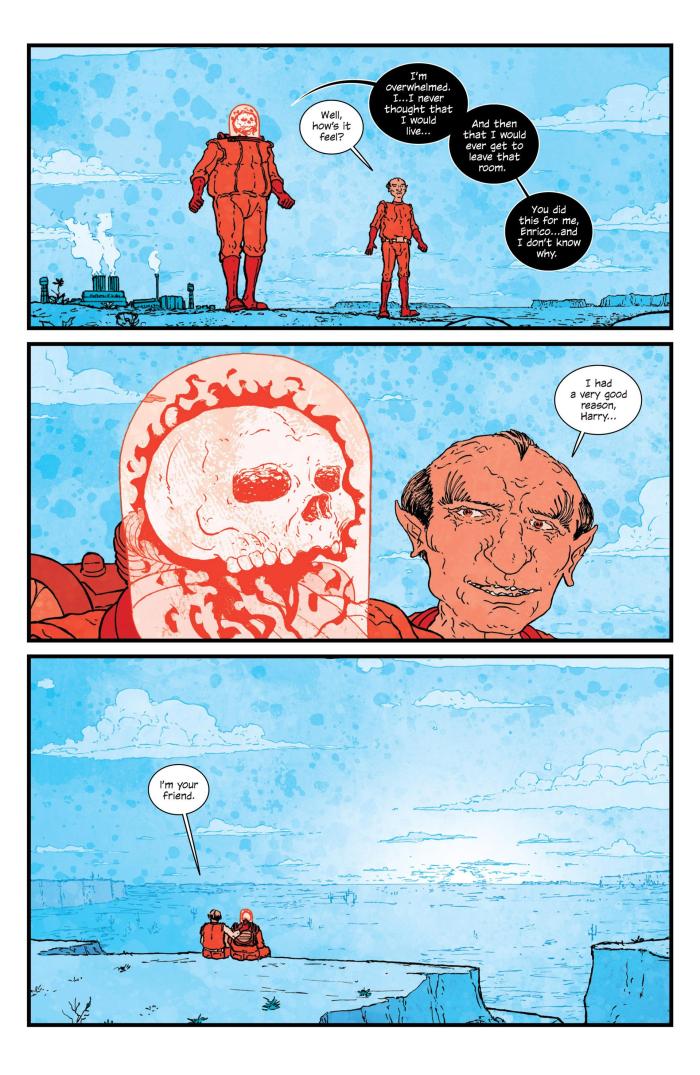 So, to wrap things up, here’s an overview of the annual standings, and what comics have made the #1 spot each year I’ve ran this feature on my blog….
So, to wrap things up, here’s an overview of the annual standings, and what comics have made the #1 spot each year I’ve ran this feature on my blog….
2010: Scalped
2011: Scalped
2012: The Underwater Welder
2013: The Manhattan Projects
Thanks for reading, everyone. Merry Christmas, and a Happy New Year!
